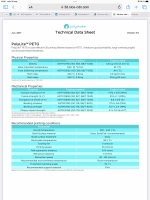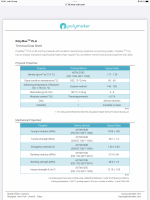In addition to what I wrote here and here, on the matter of glueing a flattened voice coil on flat membrane, here is a somewhat complicated patent mentioning more or less the same idea, but with multiple Tesla coils. Has anyone tried to use a flattened voice coil glued on flat membrane with neodymium magnets as the motor?
Also, Dayton Audio had done a flat speaker, but with a flattened voice coil glued perpendicular to flat membrane. But, I have seen more or less this idea somewhere here in this thread. The person in the video is a member here. If I am not mistaken, I've seen this idea discussed in this long thread here. Anyway, the idea is to glue the flattened voice coil on the flat membrane, either in front or at the back with the 2, 3, 4 neodymium magnets as the motor few mms away from the flat membrane. Have anyone tried this?
Thanks Fizzy,Andre Bellwood do you like these (the canvas based DML's) better than the ones you did where you hot-glued a poly disk on a panel or were those two different use cases (PA vs Home)? I've been intrigued by that ever since I read it on the DML for PA thread...
Each of those solutions has its own weaknesses. The polycarb disc in a large EPS sheet had very nice bandwidth and flatness but extremely low efficiency. I did not try a smaller size panel at that stage because I had just started experimenting and was not interested in HiFi applications anyway.
The canvas panels with inserts have better efficiency, and can be made to have fairly flat response, but they suffer from higher distortion on the bass end because of the non-linearities of the canvas surround (the bit between the insert and the frame.)
The canvas panels work very nicely at home, in an enclosed environment where they can rely on reflections to give the higher frequencies a bit of a boost. But outdoors, for PA, I've found that they do not radiate forwards very well in the all-important 3k-10khz range, and that side radiation, off the edges, is much higher than forward radiation. This leads to the panels sounding bassy and muffled at a distance of 20metres or so, but closer to stage they sound fantastic.
Last edited:
@ Andre Bellwood
What if you add a thin silicon layer on to the canvas surround at the back using a silicone tube gun? Using some sort of a wooden or plastic spatula, you can spread it over the canvas surround. If the silicon layer gets fixed to the frame and to the edge of the Nidaplast insert, the surround might get a bit stiffer and also somewhat elastic.The canvas panels with inserts have better efficiency, and can be made to have fairly flat response, but they suffer from higher distortion on the bass end because of the non-linearities of the canvas surround (the bit between the insert and the frame.)
What I do is to force a thin dowel (4 - 8mm in dia depending how tight I want the canvas) in between the canvas and the frame all around the frame, and then secure that with soft silicon in the resulting gap so the dowel does not work itself loose, and the camvas does not flap. This also means there's a slightly softer interface from the insert (Nidaplast or whatever else) to the wooden frame itself. Adding silicon to the surface will increase damping. That might or might not be useful. It might also mitigate HF edge radiation, but I will have to model all of this on the computer first because my workshop has no more space for prototypes.@ Andre Bellwood
What if you add a thin silicon layer on to the canvas surround at the back using a silicone tube gun? Using some sort of a wooden or plastic spatula, you can spread it over the canvas surround. If the silicon layer gets fixed to the frame and to the edge of the Nidaplast insert, the surround might get a bit stiffer and also somewhat elastic.
You can 3d print a lot of materials, even metal and glass. And there are printers that can put down long strands of fiber in the print. But for a regular FDM printers you are limited to things that melt at a reasonably low temperature and that can be fed easily through a nozzle with a small light extruder so it can move quickly. And there are a lot of different engineering materials that are crazy expensive, but have really good impact strength, chemical resistance, or other properties that make them useful for various constructions. But most engineering have quite different demands, and the materials good for plates are generally lousy construction materials, apart from use as insulation.Roger that. I suspect the materials science part of 3d printing will catch up with things like nomex soon enough.
We do seem to have a bit similar requirements to aerospace engineers sometimes though, where light weight combined with high stiffness is desirable. Apparently the NEXT patents come from UK air force noticing the acoustic properties of composites used in aircraft construction.
I came across this video with a model aircraft enthusiast where he is using lightweight PLA, which foams as it is extruded, making the material porous, like a quite stiff foam:
I did consider trying it out when I looked in to printing before, but was a bit fed up with trying materials with mediocre results and focused on the GPS plates instead. But the video got me thinking. The properties of the LW PLA is not really good enough on their own, but if doing like he does, sanding to open up the pores, and then cover with something hard like resin or shellac, the stiffness increases drastically without adding hardly any weight.
So I ordered a roll and gonna test it out. Have to think what density I should try with, if I should make it uniform density apart from the skin, and what would be a good thickness of the plate in relation to density.
How about a honeycomb core of LW PLA covered with treated Kraft paper or similar. The core could then be modified across the panel in terms of stiffness.
Also, the exciter region/s core could be made from standard PLA for extra strength
Would also need to be made in sections and joined to get a usable panel size whatever method is chosen.
And I presume you have ordered the std LW and not the pre-foamed stuff?
Also, the exciter region/s core could be made from standard PLA for extra strength
Would also need to be made in sections and joined to get a usable panel size whatever method is chosen.
And I presume you have ordered the std LW and not the pre-foamed stuff?
Last edited:
Point for me with testing printed version is really to not have to deal with a somewhat tricky lamination process, and not so much to save the material cost of for example nomex. So I hope that LW PLA with a honeycomb core and the surface treated with a skin of epoxy or shellac will work. It will probably not beat the GPS, but worth a try.
I have a 800x800x1000mm printer coming in a few months, so will be able to print decent size panels 🙂
Planning to print subs and some decorations, hence the massive printer. Been thinking a bit about it, and would save so much work compared to CNC and assembling wood panels, and by printing an empty shell and filling it with for example plaster mixed with PVA it is not that slow to print, and cheaper in material cost than wood but not problem to compete in stiffness and damping.
Yes, it is Colorfabb LW PLA which you can control density with temperature.
I have a 800x800x1000mm printer coming in a few months, so will be able to print decent size panels 🙂
Planning to print subs and some decorations, hence the massive printer. Been thinking a bit about it, and would save so much work compared to CNC and assembling wood panels, and by printing an empty shell and filling it with for example plaster mixed with PVA it is not that slow to print, and cheaper in material cost than wood but not problem to compete in stiffness and damping.
Yes, it is Colorfabb LW PLA which you can control density with temperature.
I've been testing 3D print panels with intresting results. I prefer to keep my speakers fairley small in order to use them in the living room without to much complaints...
I'm using simple PLA for the panel and frame, The panel has 20 % infill and the top an bottom layers are 0.2 mm. The layout of the panel is inspired by the Goebels high end bending wave. The frame is also 3D printed and filled with plaster for stabillity and weigth.
It sounds pretty darn good after a bit of EQ. I'm using Camilla DSP. I'm also using subwoofers below 100 Hz.
They are almost as good as my Carbon fibre panel with cross grain balsa core (2mm). See earlier posts.
I'm using a Tectonic exciter TEAX 25C05.
I've included 2 FR measurements and 2 Distorsion measurements. There are, as you can see, some resonances that needs to be controlled. This is quite easy with EQ as you can see.
I'm using simple PLA for the panel and frame, The panel has 20 % infill and the top an bottom layers are 0.2 mm. The layout of the panel is inspired by the Goebels high end bending wave. The frame is also 3D printed and filled with plaster for stabillity and weigth.
It sounds pretty darn good after a bit of EQ. I'm using Camilla DSP. I'm also using subwoofers below 100 Hz.
They are almost as good as my Carbon fibre panel with cross grain balsa core (2mm). See earlier posts.
I'm using a Tectonic exciter TEAX 25C05.
I've included 2 FR measurements and 2 Distorsion measurements. There are, as you can see, some resonances that needs to be controlled. This is quite easy with EQ as you can see.
Attachments
-
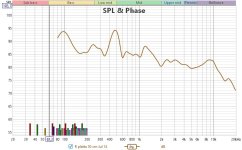 GIPS platta R 30 cm .jpg96.9 KB · Views: 140
GIPS platta R 30 cm .jpg96.9 KB · Views: 140 -
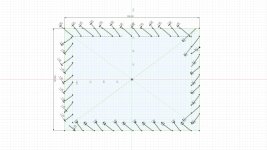 membran v20.jpg190.8 KB · Views: 143
membran v20.jpg190.8 KB · Views: 143 -
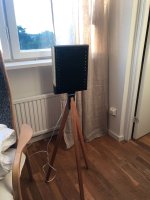 IMG_5639.jpg398.2 KB · Views: 146
IMG_5639.jpg398.2 KB · Views: 146 -
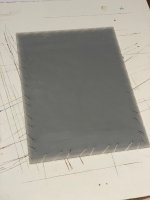 IMG_4803.jpg288.8 KB · Views: 145
IMG_4803.jpg288.8 KB · Views: 145 -
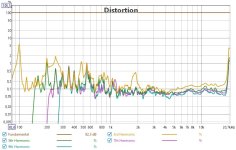 GIPS platta R 30 cm med eq Distorsion .jpg78.4 KB · Views: 144
GIPS platta R 30 cm med eq Distorsion .jpg78.4 KB · Views: 144 -
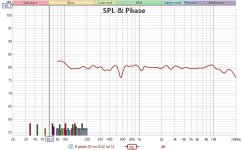 GIPS platta R 30 cm med eq .jpg96.2 KB · Views: 135
GIPS platta R 30 cm med eq .jpg96.2 KB · Views: 135 -
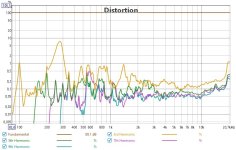 GIPS platta R 30 cm distorsion .jpg83 KB · Views: 135
GIPS platta R 30 cm distorsion .jpg83 KB · Views: 135
Very nice Sandasnickaren! Response looks much better than I got with my attempts. I never tested them suspended though I realized now, which I think can make a big difference for the low end response. But you seem to get decent high frequency response as well. What brand of PLA? You have any idea about the sensitivity compared to something like EPS?
It’s Creality hyper PLA.
They are suspended on 2 mm EPDM foam. I’ve been using EPDM on all my panels.
I haven’t tried EPS lately so I can’t compare to those.
However the sensitivity is ok for my living room. I can do a measuremen of sensitivity after the weekend.
They are suspended on 2 mm EPDM foam. I’ve been using EPDM on all my panels.
I haven’t tried EPS lately so I can’t compare to those.
However the sensitivity is ok for my living room. I can do a measuremen of sensitivity after the weekend.
Maybe this one?I have a 800x800x1000mm printer coming in a few months, so will be able to print decent size panels
Have you figured out how long it will take to print a sub box??
Correct, not many printers in that dimension, apart from some commercial machines starting for 10x the price 🙂
There is the Tronxy VEHO which can be up to 1000x1000x2000. But the Elegoo prints faster and seems to be a better machine. I will probably upgrade it with Luke Laboratories kit with beacon probe for levelling and a better extruder.
I think I figured out a good way to print the sub in 6 parts, baffle, hatch and top and bottom of front and back. Without supports and hollow with 2x0.8mm thick walls printed diagonally for strength. According to Elegoos slicer settings it will take a bit less than a week in total to print all parts. Hopefully with some tweaking I can reduce that significantly. The limit is really the flow rate, which is relatively easy to upgrade.
Since I need to have some joints, I think I will want to cover the plastic, which also means I can print quickly without nice surface finish, and use PLA for the structure which is cheap, non poisonous, eco friendly and fast and easy to print. Problem is that it is not that UV and shock resistant, but if it is covered and protected that is not an issue. TPU sheets would be extremely durable and shock resistant, and can can also be printed with grooves to fit into the PLA structure, and can have print lines smoothed out for a non-3d printed look. One should be able to paint them with something like Raptor as my plywood subs, but that is expensive, not fun, toxic and requires a dedicated space.
There is the Tronxy VEHO which can be up to 1000x1000x2000. But the Elegoo prints faster and seems to be a better machine. I will probably upgrade it with Luke Laboratories kit with beacon probe for levelling and a better extruder.
I think I figured out a good way to print the sub in 6 parts, baffle, hatch and top and bottom of front and back. Without supports and hollow with 2x0.8mm thick walls printed diagonally for strength. According to Elegoos slicer settings it will take a bit less than a week in total to print all parts. Hopefully with some tweaking I can reduce that significantly. The limit is really the flow rate, which is relatively easy to upgrade.
Since I need to have some joints, I think I will want to cover the plastic, which also means I can print quickly without nice surface finish, and use PLA for the structure which is cheap, non poisonous, eco friendly and fast and easy to print. Problem is that it is not that UV and shock resistant, but if it is covered and protected that is not an issue. TPU sheets would be extremely durable and shock resistant, and can can also be printed with grooves to fit into the PLA structure, and can have print lines smoothed out for a non-3d printed look. One should be able to paint them with something like Raptor as my plywood subs, but that is expensive, not fun, toxic and requires a dedicated space.
This got me to thinking as well.... one way to possibly increase the stiffness even more is if after you grid the LW PLA and paint it with resin you place it in a chamber vacuum machine? I'll stay tuned to your experiment and if you have some success I might borrow my cousins chamber vaccum machine and see if we can take this further assuming you guys think this might bear fruit?I did consider trying it out when I looked in to printing before, but was a bit fed up with trying materials with mediocre results and focused on the GPS plates instead. But the video got me thinking. The properties of the LW PLA is not really good enough on their own, but if doing like he does, sanding to open up the pores, and then cover with something hard like resin or shellac, the stiffness increases drastically without adding hardly any weight.
So I ordered a roll and gonna test it out. Have to think what density I should try with, if I should make it uniform density apart from the skin, and what would be a good thickness of the plate in relation to density.
After a bit of fiddling I was able to get a great FR with canvas panels and honeycomb cardboard but the SPL is really low, like in the mid 80s (I have a pair of old sony ss2050 that are rated at 91db at 1w/1meter that are much much louder). Any advice on that? Is my best bet using something lighter than cardboard?
Hi Cannibal,
You could try cutting away the middle of the canvas so only an inch or so remains around the outside to hold it, this would maybe increase the sensitivity as it would lower the weight/damping on the surface of the panel.
I have found with my limited experiments that the canvas panels distort with low bass when playing at higher SPL. My latest plays to under 50hz at lower volume but when I turn it up it gets distorted.
You could try cutting away the middle of the canvas so only an inch or so remains around the outside to hold it, this would maybe increase the sensitivity as it would lower the weight/damping on the surface of the panel.
I have found with my limited experiments that the canvas panels distort with low bass when playing at higher SPL. My latest plays to under 50hz at lower volume but when I turn it up it gets distorted.
Got the LW PLA and made a couple of small test prints just to get an idea about print settings and material properties before I print a small test plate to put an exciter on. It does seem like an interesting material and could have potential for DML plates. Get it to print at 50% density, and a bit of tuning needed with the flow rate, but seems to be easy to print otherwise.
It does smell quite a bit when printing though, so I think I will leave further experiments until I have set up a new separated space for printers.
There are a lot of parameters to figure out though.
One option is to print multi material, so regular PLA as honeycomb infill with LW PLA skins. Regular PLA weighs more but I think the question is which gives the best compressive strength compared to density, so for example 0.3mm wide wall of PLA or a 0.6mm wall of LW PLA.
According to tests by Stephan at CNC kitchen, the LW PLA is a lot less stiff when you print at temps which gives around 50% density:
 But enforcing it with a little resin seems can hopefully can get a stiffness to weight ratio that improves on regular PLA. Of course the infill cannot be treated the same way, and I think the LW PLA doesn't fare too well on its own when it comes to compressive strength either, so perhaps using regular PLA for infill would be preferable.
But enforcing it with a little resin seems can hopefully can get a stiffness to weight ratio that improves on regular PLA. Of course the infill cannot be treated the same way, and I think the LW PLA doesn't fare too well on its own when it comes to compressive strength either, so perhaps using regular PLA for infill would be preferable.
It does smell quite a bit when printing though, so I think I will leave further experiments until I have set up a new separated space for printers.
There are a lot of parameters to figure out though.
One option is to print multi material, so regular PLA as honeycomb infill with LW PLA skins. Regular PLA weighs more but I think the question is which gives the best compressive strength compared to density, so for example 0.3mm wide wall of PLA or a 0.6mm wall of LW PLA.
According to tests by Stephan at CNC kitchen, the LW PLA is a lot less stiff when you print at temps which gives around 50% density:
Leob...
I think this material is worth a try
https://www.amazon.com.au/Filament-...7063f28249173bd99079e6e77d0facca&gad_source=1
(For the core)
Available in white also
Unfortunately, PLA probably can't stand the PC temperatures, so can't be printed together...Edit... Not so sure about that... There's a Reddit post where someone printed a PLA raft and then finished with PC on top
I think this material is worth a try
https://www.amazon.com.au/Filament-...7063f28249173bd99079e6e77d0facca&gad_source=1
(For the core)
Available in white also
Unfortunately, PLA probably can't stand the PC temperatures, so can't be printed together...Edit... Not so sure about that... There's a Reddit post where someone printed a PLA raft and then finished with PC on top
Last edited:
Thanks for the tip! Seems to be the same as available on Amazon.se...very affordable for a PC blend filament.
The LW PLA can print up to 280c, and I have a printer with multiple extruders to test on. Question is if the materials will bond. PETG and PLA does not, so works well to combine for rafts or supports that you don't want to adhere, but would be bad for this application.
The LW PLA can print up to 280c, and I have a printer with multiple extruders to test on. Question is if the materials will bond. PETG and PLA does not, so works well to combine for rafts or supports that you don't want to adhere, but would be bad for this application.
Some thougths on 3D printed panels/membrane
There are three different aspects to consider. One being the filament and its mechanical properties (young modulus, tensile strength and compression) secondly being the design of the panel/membrane i.e. the size, ratio and the thicknes thirdly is the printing properties i.e. the thickness of the skinns, the amount of infill and shape. Of the infill.
all of these combined will determine the mechanical properties of the Panel/membrane and how it sounds.
There are quite a lot of theory in patents and research papers on how to optimize a DML/Bending wave panel considering both size and mechanical properties. Unfortunately they are not really very conclusive And leaves room for experimenting.
I choose PLA for my first attempt as reported in earlier post the size, thickness of the panel, thickness of the skins and infill was based on my earlier experiences with balsa and carbonfibre. The interesting thing is that the 3D panel i less efficient compared to the CF panel but has a wider frequency response both low and high 80-20000. 3D panel does also generate a bit more distorsion.
I intend the continue experimenting with other material using the same design and printing settings in order to be able to compare the different materials. I’m planning to test polycarbonate, PETG.
There are three different aspects to consider. One being the filament and its mechanical properties (young modulus, tensile strength and compression) secondly being the design of the panel/membrane i.e. the size, ratio and the thicknes thirdly is the printing properties i.e. the thickness of the skinns, the amount of infill and shape. Of the infill.
all of these combined will determine the mechanical properties of the Panel/membrane and how it sounds.
There are quite a lot of theory in patents and research papers on how to optimize a DML/Bending wave panel considering both size and mechanical properties. Unfortunately they are not really very conclusive And leaves room for experimenting.
I choose PLA for my first attempt as reported in earlier post the size, thickness of the panel, thickness of the skins and infill was based on my earlier experiences with balsa and carbonfibre. The interesting thing is that the 3D panel i less efficient compared to the CF panel but has a wider frequency response both low and high 80-20000. 3D panel does also generate a bit more distorsion.
I intend the continue experimenting with other material using the same design and printing settings in order to be able to compare the different materials. I’m planning to test polycarbonate, PETG.
Attachments
- Home
- Loudspeakers
- Full Range
- A Study of DMLs as a Full Range Speaker
